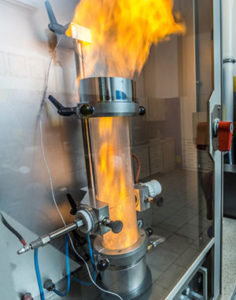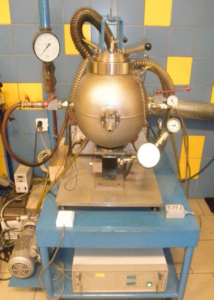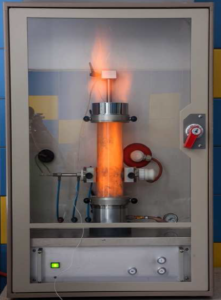EXPLOSION TESTING
What can MSPS do for you? We give you clarity about the dust explosion properties of your substances. Carry out affordable, reliable and professional dust explosion tests. Including full documentation from the recognized laboratory.
Explosion dust testing

In order to make a correct risk analysis / assessment or explosion protection, it is important that the explosion properties of the substance (raw materials) are known. It often happens that these properties of the substance are not known or that these values are not entered on the Safety Data Sheets. This will NOT say that the substance is not or cannot be explosive.
About 75 percent of all powdered products can give an explosive atmosphere under ideal conditions. Process conditions have a major influence on the explosion properties of a substance. This includes humidity, particle size, and temperature
Performing a ATEX explosion dust test
Accredited lab according EN ISO/IEC 17025
To investigate if your dust is explosive, we can offer you various dust explosion tests. These explosion tests are carried out in a acredited laboratory. This guarantees that all tests are performed professionally and with the correct equipment and trained personal. We explain the most important research steps or methods for the explosion properties below. We carry out dust investigations in accordance with various European (EN standards) standards. For this it is necessary to follow the applicable protocols. Which protocols these are exactly depends on the tests to be performed.
Do you want a price for dusttesting?
Explanation of explosion dust testing we offer.
The product is offered at the Laboratory. Basic steps for dust sample preparation for all explosion test:
1) Prepared to the correct fineness and sieved.
During this study, the determination of medium size takes place.
This investigation is required by various standards for conducting fire or explosion dust investigations.
2) Research moisture content
During this process, the moisture percentage in the dust particles is measured. The product is heated to approximately 105 degrees Celsius
3) Primary Chemical Analysis
During this process, the combustible materials, ash and solid carbon are determined. The product is heated to approximately 815 degrees Celsius for the determination of As, then it is further heated to approximately 900 degrees Celsius to determine the non-combustible part.
Before performing more specific tests, it is sometimes recommended to perform a screening test to determine if the powder sample can cause a dust explosion.
It results in one of two possible outcomes:
Group A (Explosible/hazardous) – the dust cloud propagates flame from the ignition source and is classed as a combustible and potentially explosible material.
Group B (NON EXPLOSIBLE/ non hazardous)
NOTE: When the outcome of the first part is “NOT EXPLOSIBLE/nonhazardous” the test is not done. The test will then also be done in a closed vessel and test with a higher ignition energy to be sure it can be considered as a not explosible dust.
The test is carried out to EN ISO/IEC 80079-20-2:2016 Explosive atmospheres – Part 20-2: Material characteristics – Combustible dusts test methods
During this investigation, the determination of burning behaviour of dust layers takes place according EN 17077
Explanation method:
The determination of the burning behaviour enables assessment of whether a material layer, when in contact with an external ignition source shows a reaction such as ignition or smouldering. It also measures the ability of the locally induced reaction to propagate through the material in bulk or layer form. The behaviour in the test is characterized as a combustion class 1 to 6. The burning class allows qualitative estimations on the burning behaviour of a dust layer as well as on the probability of transfer of glowing particles and glowing nests from upstream connected parts of a plant.
In addition to that the burning class is used as basis to decide whether fire prevention and protection measures are necessary The material under test is first sieved to remove particle sizes greater that 250 micron, then poured onto a fire-resistant plate to form an unbroken strip of test material approximately 40 mm long by 20 mm wide and contained within a glass tube. A light airfow through the tube is maintained during the test in the direction of combustion propagation to remove any gases that may inhibit combustion. An electrically heated glowing platinum wire is applied at one end of the product strip for 5 seconds and the course of combustion is observed and recorded.
The test can be performed at room temperature or at elevated temperature or at specific temperatures to match process conditions (e.g. drying ovens).
During this investigation, the determination of the minimum ignition temperature of a dust layer takes place in accordance with EN 80079-20-2
Explanation method:
Minimum ignition temperature of dust layer is defined as minimum temperature of hot surface. The LIT is the temperature at which the dust layer of a certain thickness (usually 5 mm) ignites when placed on the hot surface. Dust layers are formed by filling a mold made of metal ring of the corresponding height. After which placed on a heated surface. The test is repeated until the minimum ignition temperature is established. The lowest ignition temperature measured is ultimately included in the test results.
Application:
The method is particularly suitable for industrial equipment on which a thin layer of dust is present, e.g. electric motors, lamps. The parameter determines maximum allowable surface temperature, which prevents the material from forming on a hot surface. Where there is the possibility that dust layers in a company be formed, the maximum permissible surface temperature must be reduced. By testing the layer ignition temperature, fires caused by hot surfaces may be avoided. The temperature of motor casings, light fittings etc can be limited to less than the layer ignition temperature (LIT) with a suitable safety margin – usually 75 o C
The test is carried out to EN ISO/IEC 80079-20-2 Explosive atmospheres – Part 20-2: Material characteristics – Combustible dusts test methods
The minimum ignition temperature (MIT) is the lowest temperature of a hot surface that will cause a dust cloud, rather than a dust layer, to ignite and propagate flame. During this investigation, the determination of the minimum ignition temperature of a cloud takes place in accordance with EN 80079-20-2
Explanation method:
A sample of the combustible dust is placed in a dust holder at the top of a temperature controlled furnace with an open bottom. The dust is dispersed by compressed air downwards past the hot surface of the furnace to see if ignition occurs and flames are produced. Determining the minimum ignition temperature is important for dust explosion prevention.
The test is carried out to EN ISO/IEC 80079-20-2 Explosive atmospheres – Part 20-2: Material characteristics – Combustible dusts test methods
During this investigation, the determination of the lowest explosion limit (LEL) takes place in accordance with EN 14034-3
The lower explosion limit is defined by the lowest concentration of air and the combustible dust mixture. (Also known as the MEC; minimum explosible concentration)
Explanation method:
The test is very valuable to determine the critical limit when the air dust concentration is explosive. This test is performed on standardized test equipment (autoclave 20lt bulb). The combustible dust is placed in the dust container and the explosion chamber is evacuated to pressure. An automatic test sequence is initiated to pressurise the dust container and activate the two igniters.
A test series is undertaken with a systematic decrease of the dust concentration until no ignition of the dust / air mixture is observed. The test is repeated to ensure no ignition is found in three consecutive tests.
Application:
The lower explosible limit (LEL) may be used as an explosion prevention method in areas where the explosive concentration of dust can be reliably controlled. Explosion testing for the lower explosible limit is also helpful when deciding hazardous area zones for dust (e.g. zone 20, zone 21 & zone 22)
The test is carried out to EN 14034-3 (determination of the lower explosible limit LEL of dust clouds)
During this investigation, the determination of the maximum explosion pressure Pmax takes place in accordance with EN 14034-1 &EN 14034-2. The Pmax / maximum explosion pressure and the Kst value describe the explosive behavior of a combustible dust/air mixture in a closed system.
This test is performed standardized test equipment (autoclave 20lt-bol)
Kst values (bar.m/s) Explosion dust classes (St. Class)
1 – 200 1
200 – 300 2
>300 3
This test is indispensable to estimate an explosion hazard.
Explosion testing for Kst value & Pmax is essential to validate protection design (explosion venting, explosion suppression and explosion containment).
Explanation method:
The tests are carried out in a 20 litre standardized sphere apparatus which reproduces a high state of turbulence to simulate worst case process plant conditions. Most process equipment will not be sufficiently strong to withstand the typical pressures generated dust explosions.
A quantity of combustible dust is placed into the dust container. The main explosion chamber is then evacuated to 0.4 bar absolute. An automatic test sequence is initiated to pressurise the dust container to +- 20 bar gauge, and then the fast acting valve on the dust container outlet is opened to allow material into the explosion chamber. The special nozzle ensures an even distribution of the dust within the explosion chamber. The system activates two igniters at the centre of the sphere after the dust has been dispersed. Explosion pressures are measured for a range of dust concentrations using piezo-electric pressure transducers. The tests are carried out over three series to ensure a thorough investigation of the explosion properties.
KST-value:
The Kst value and Pmax are explosive properties quantify the severity of a dust explosion. The Kst value is calculated as the equivalent pressure in a 1 m 3 sphere. The ST class is based on the Kst value as follows: ST class 0 – Kst value = 0 ST class 1 – Kst value less than 200 bar m/sec ST class 2 – Kst value between 200 and 300 bar m/sec ST class 3 – Kst value greater than 300 bar m/sec
The test is carried out to EN 14034-1 & EN 14034-2 (determination of the maximum rate of explosion pressure rise of dust clouds Kst).
During this investigation, the oxygen concentration is determined in accordance with EN 14034-4
This test is performed on standardized test equipment (autoclave 20lt bulb). By reducing the oxygen concentration step by step (by adding nitrogen), it is determined when the substance no longer gives an explosive reaction.
Explanation method:
The limiting oxygen concentration (LOC) is the highest concentration of oxygen that prevents a combustible dust forming an explosive atmosphere.
An amount (5 gr) of combustible dust is placed in the dust container and the explosion chamber is filled with a known concentration of oxygen in nitrogen. An automatic test sequence is initiated to pressurise the dust container and activate the ignition after the dust has been dispersed. Once ignition is achieved at a known oxygen concentration, the level of oxygen is reduced until a point is reached at which no ignition occurs.
Application:
The parameter is necessary when determining inertization technologies.
The test is carried out to EN 14034-4:2004 (Determination of the limiting oxygen concentration LOC of dust clouds).
During this investigation, the determination of minimum ignition energy (MIE), by electrical spark in accordance with EN 80079-20-2
Explanation method:
The minimum ignition energy (MIE) test measures the ignition of a dust cloud by electrical and electrostatic discharges. Using a spark with controllable energy content, the minimum ignition energy (MIE) of the powder is determined in the MIKE3 device.
The MIE apparatus consists of a borosilicate tube placed over a dispersion cup and fitted with two electrodes. The electrodes are connected to a circuit that produces an electrical spark of known energy. A sample of combustible dust is placed in the dispersion cup, which is blown up through the tube with compressed air past the ignition source.A modified glass Hartman tube (of 1.2l) is used as the explosion vessel. The sample of the dust is freely dispersed in the tube by the built-in dust dispersion system. After which the substance is ignited by a spark between two electrodes. The value of the minimum energy is used to exclude possible initiation source.
If flame propagation is observed, the energy of the spark is reduced until no flame propagation is seen for 10 consecutive tests. At that spark energy, a range of dust sample weights is tried to thoroughly investigate potential dust explosion concentrations. The test result is stated as an energy range, indicating that ignition took place at the higher value and no ignition took place at the lower value. The MIE is a measure of how sensitive an explosive dust cloud is to electrical spark ignition.
Application:
Determining the minimum ignition energy is important for determining the energy required to explode a substance. Consider, for example, electrostatic sparks.
Testing for minimum ignition energy gives guidance on whether ignition by electrostatic discharge from personnel or process conditions is likely to occur in practice.
The test is carried out according to EN ISO/IEC 80079-20-2 (Explosive atmospheres Part 20-2: Materialcharacteristics – Combustible dusts test methods).
During this examination, it is determined in which sizes your fabric is conductive. The examination is carried out in accordance with ISO/IEC 80079-20-2
This test determines powder volume resistivity by the simultaneous measurement of voltage and current passing through a test sample of known cross sectional area and depth.
Explanation method:
An insulated measuring plate is used with two raised electrodes forming the sides. Material is placed into the cell and levelled across the electrodes. DC voltage is applied to the electrodes and current flow is measured by a suitable ammeter. The test is repeated and the average measured current and applied voltage determined so that the electrical resistance across the electrodes may be calculated.
The powder resistivity is derived from the average calculated resistance, height and length of the electrodes and space in between.
A powder is considered to be conductive if the resistivity is less than 10³ Ωm. (and therefore capable of shorting electrical or electronic equipment when present in this equipment)
The test method is described in EN ISO/IEC 80079-20-2:2016 (Explosive atmospheres Part 20-2: Material characteristics – Combustible dusts test methods).
Self heating materials
In order to safely transport, store and handle materials without risk of fire or spontaneous combustion, laboratory scale oven tests have been developed that allow scale up to much larger industrial size applications.
Two tests are available:
1) Isothermal basket test
2) RID/ADR
Explanation method:
The material under test is filled into a cube shaped basket ranging in size from 25mm to 100mm and made of stainless steel mesh. The basket is suspended in an air circulating oven, preheated to a known temperature, with thermocouples both inside out outside the basket to record temperature. Data logging is used to plot temperature against time during the test which may last up to 48 hours. Two types of behaviour are observed: sub-critical, where the sample temperature increases above oven temperature, but then slowly drops back after reaching a peak; super-critical, where the sample temperature continues to rise above oven temperature and heats to ignition. The division between these two behaviours is quite sharp with most self heating materials and is usually determined to an accuracy of 2K. By plotting the logarithms of the volume to surface area ratios of differently sized samples versus the reciprocal values of the respective self ignition temperatures, a straight line is produced. The line may then be extrapolated to give insight into the self ignition behaviour of material held in much larger storage and process conditions.
UN 4.2 Classification – substances liable to spontaneous combustion
The UN 4.2 classification is a similar isothermal basket test, but groups materials based on ignition / non ignition in two sizes of basket and at three different oven temperatures. Testing is required for dangerous materials under the UN Recommendations on the Transport of Dangerous Goods.
Laboratory oven tests are carried out according to EN 15188 (Determination of the spontaneous ignition behaviour of dust accumulations).
Examples of the explosion dust testing equipment
Testing equipment for MIT

Determination of the minimum ignition temperature of a cloud takes place in accordance with EN 80079-20-2
Testing equipment for Pmax, dp/dt, LEL, LOC

Determination of the explosion properties of a dustcloud takes place in 20 ltr sphere that can resist an explosion pressure of 30 bar accordance with EN 14034-1 EN 14034-4.
Testing equipment for MIE

The minimum ignition energy (MIE) of the powder is determined in the MIKE3 device. (EN 13821 / EN ISO 80079-20-2)
Would you like to receive a quote for conducting dust research?
Stay up to date! Signup for the ATEX- Explosion prevention newsletter.

